|
Frankenstein beyond 2000
Dean Koontz'
Frankenstein (2004)
| The year
2004 saw the release of two Frankenstein films at practically the
same time. Although both were produced for TV, they are completely
different in their approach concerning story, style and setting.
While Hallmark Entertainment's Frankenstein mini series is a
faithful retelling of Shelley's novel, USA Cable Network's
Frankenstein film adapts a novel by Dean Koontz, which is some sort
of modern day sequel to Shelley's original work. |
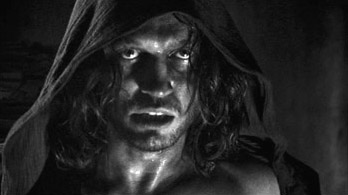
If only Karloff had looked like him: Vincent Perez as Deucalion,
the first Frankenstein monster |
Synopsis:
Detectives Carson O'Conner and Michael Sloane follow a series of grisly
murders in New Orleans, where the victims are dissected and organs are
removed in bloody fashion. They soon get help from a mysterious man
named Deucalion, who turns out to be Frankenstein's first creation and
has been roaming the earth for 200 years. He reveals to the detectives
that his creator is a famed scientist named Victor Helios, who also
lives in New Orleans and mysteriously has managed to extend his
lifespan. Having achieved near perfection, Helios now produces
artificial beings on a large scale, who populate the city and live among
the humans unrecognised. These creatures are much stronger than humans,
yet they seem to have a longing for death, although they are unable to
end their own lives. Aided by Deucalion, who exclaims, "I am not the
Monster anymore. I am your best hope", Carson and Sloane discover the
identity of the serial killer: fellow detective Harker, who actually is
one of Helios' creations. Being denied the ability to recreate, Harker
begins to kill off Helios' creations as an act of rebellion against his
creator. Striving to create the perfect mate, Helios meanwhile kills his
(artificial) wife Erika who is unable to satisfy him, and replaces her
with a new wife created in his laboratory.
Carson is finally able to track down Harker in an abandoned factory.
When she fails to shoot him, Deucalion arrives just in time and throws
Harker from a platform to his death. Deucalion and Carson finally decide
to work together to stop Helios from populating the whole world with his
race of artificial humans.
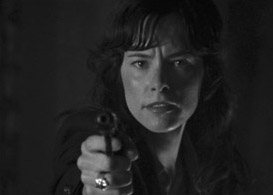
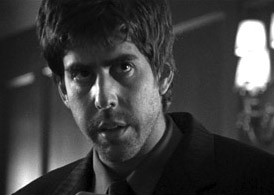
Like Scully and Mulder: Detectives Carson O'Conner (Parker Posey) and
Michael Sloane (Adam Goldberg)
Here Frankenstein, or rather Helios, has finally achieved what Mary
Shelley's hero only imagined: he is populating the world with a race of
his creations, superhuman in strength and seemingly perfect. Helios
regards himself as their God, which is emphasized in several
conversations he has with a priest, who actually is also one of his
creations. Knowing that the priest is hiding fugitive Harker from him,
in one scene Victor asks him, if he believes that one can lie to his
God. Of course in this case "God" refers to Helios and the priest
painfully has to discover, that nothing can be kept from his creator
when he ultimately has to pay with his life for his betrayal.
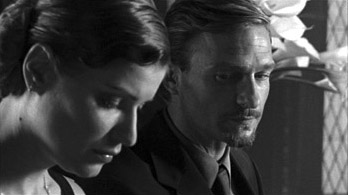
A doomed relationship:
Victor Helios (Thomas Kretschmann) and Erika (Ivana Milicevic) |
Of course it is not always that easy for Victor Helios to kill his
creatures. Before he drowns his wife Erika, hopelessly suicidal and
regarding herself a failure, he lovingly kisses her and admits,
"This is difficult for me. I am a creator, not a destroyer." But he
also assures her that because of her sacrifice there will be a
better, a perfected future. |
Director Marcus Nispel's
film makes references to Shelley's book several times. Once Sloane asks
Carson if the killer is some sort of Frankenstein, and she answers that
Frankenstein is the doctor, not the monster - a nod to the widespread
misconception of the Frankenstein myth where the creature is referred to
as Frankenstein.
Deucalion later reveals to Carson, "Frankenstein is fiction based on
fact. That fact is Victor Helios." This implies of course that Victor
Helios is in fact the scientist on whom Shelley modelled her fictional
character Victor Frankenstein. Therefore the movie assumes that the
story of Frankenstein as conceived by Mary Shelley, is partly based on
true facts. This almost post-modern approach puts Nispel's movie in line
with Brian Aldiss' novel
Frankenstein Unbound,
adapted for the big screen by Roger Corman in 1990, and centered arounda
similar conception.
Based loosely on Dean
Koontz's series of Frankenstein novels, this was supposed to be the
pilot to an ongoing weekly TV series, co-produced by Martin Scorsese.
Due to artistic differences, Koontz left the project and it was stopped
with only the pilot completed. This is rather sad, since the film is one
of the best continuations of the Frankenstein stories in many years,
ripe with interesting ideas blending traditional and modern horror
elements with The X-Files, and technically well-executed by music
video director Marcus Nispel, best known for his remake of the
Texas Chainsaw Massacre. Drenched in a morbid atmosphere taken
straight from David Fincher's
Se7en, Frankenstein's muted color palette and rapid
MTV-style editing create an eerie mood of contemporary gothic horror.
Thanks to the excellent cast the film often belies its low budget and it
is really a pity that after 90 minutes no conclusion is offered. The
cliffhanger ending leaves the viewer unsatisfied, hoping that ultimately
at least a sequel will be produced.
|
Cast & Crew: |
|
| |
|
|
Carson O'Connor |
Parker Posey |
| Deucalion |
Vincent Perez |
| Viktor Helios |
Thomas Kretschmann |
| Harker |
Michael Madsen |
| Michael Sloane |
Adam Goldberg |
| |
|
| |
|
|
Screenplay |
John Shiban
Dean Koontz |
|
Music |
Normand Corbeil |
|
Cinematography |
Daniel Pearl |
| Producers |
Marcus Nispel
Martin Scorsese
Kimberly Anderson |
| Director |
Marcus Nispel |
Frankenstein (2004)
Hallmark Entertainment's 4-part TV mini series has often been hailed as THE most faithful retelling of Mary Shelley's novel to
date. Unlike Kenneth Branagh's 1994
movie, which made similar claims, director Kevin Connor's version adapts the novel without
making any major changes. It contains all the important episodes from
the novel, even the narrative frame with Robert Walton is intact. Apart from
giving away the secret of life – once again Victor Frankenstein uses
electricity created by a thunderstorm to bestow life upon his creature – screenwriter
Mark Kruger has not added any new plot devices such as the re-animation
of Elizabeth in Branagh's film.
| Kevin Connor's version
carefully recreates the 19th century period settings and beautifully
designed costumes. However, much of the realism is lost due to the
fact that here everything looks a bit too clean and sanitized. Being
a rather colorful movie, it is far removed from the horror of other
adaptations. Emphasizing the melodrama, Connor gives more space to
the love story between Victor and Elizabeth, playing down the gothic
horror elements and violence. Clerval and Professor Waldmann, who
repeatedly warn Victor of the possible consequences of his doings,
also get much more screen time than in previous movies. This
adaptation focuses not on the action but on character development
and psychology. This approach might scare away horror buffs, but
since Shelley's novel has never really ranked as a horror story, it
is ultimately a more faithful adaptation than most before.
|
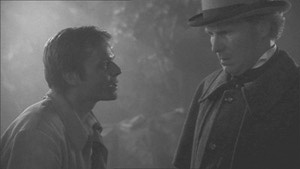
Victor (Alec Newman) cannot convince Professor Waldmann (William
Hurt) to help him bag some leftover body parts |
Here the portrayal of the monster also differs from most other
adaptations. Former pop singer Luke Goss plays the monster as a pitiful,
kind
creature, filled with sadness rather than anger. There are many such
instances where the audience witnesses the monster's misery. When the
blind man and his granddaughter give him food, he bursts out in tears
because they are the first people who have treated him with such sort of
kindness. When he takes Justine's hanged body down from the gallows, he
apologizes to her. In his conversation with Victor it turns out the
monster killed the boy William accidentally, in fact he never wanted to
harm him. However, when he planted the medallion on Justine, he clearly
states that he condemned her to hurt Victor. Speaking with a soft voice
and calling Frankenstein "father", the creature rarely is a menace, but
rather the one the audience sympathizes with. When he sees his future
bride, lifeless on the operating table in the lab, the monster promises
to her how he would show her love and care for her. His disappointment
and anger becomes perfectly understandable, when instead of giving life
to the bride, Victor burns her in front of his creature. This is finally
the point, where the monster's sorrow turns to hate.

Is he the singer of a Finnish black metal band or Frankenstein's
monster (Luke Goss) |
The
ensuing path of revenge – the creature kills both Clerval and
Elizabeth – and Frankenstein's hunt for the monster, who keeps
leaving hints for him to follow all over Europe, is a welcome change
of pace. The melodrama is replaced by more action that only ends
when the monster finally finds dead Victor Frankenstein on
board of Walton's ship and disappears into the arctic ice carrying his
creator's body, after having explained his motives to Walton. |
|
Connor's Frankenstein has often been
criticized as being too slow and long – with a running time of
about 180 minutes it surely ranks among the longest Frankenstein
films. Some might even see this first fully faithful adaptation
as proof, that Shelley's novel does not translate well to the
screen without major cinematic changes. But this only applies if
one expects a horror movie, a conception based on earlier
adaptations. If Frankenstein is seen as what it is, a gothic
melodrama, then this movie does it full justice. |
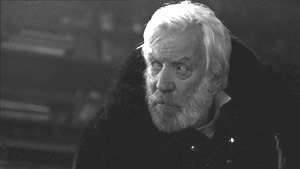
Is Donald Sutherland Captain Birdseye or
Captain Robert Walton? |
|
Cast & Crew: |
|
| |
|
|
Carson O'Connor |
Parker Posey |
| Deucalion |
Vincent Perez |
| Viktor Helios |
Thomas Kretschmann |
| Harker |
Michael Madsen |
| Michael Sloane |
Adam Goldberg |
| |
|
| |
|
|
Screenplay |
John Shiban
Dean Koontz |
|
Music |
Normand Corbeil |
|
Cinematography |
Daniel Pearl |
| Producers |
Marcus Nispel
Martin Scorsese
Kimberly Anderson |
| Director |
Marcus Nispel |
Frankenstein
Reborn (2005)
The film starts out with the gruesome murder of a young woman. Next we
see psychiatrist Robert Walton interviewing his patient Dr. Victor
Franks, a neurosurgeon accused of multiple murders. Franks
recounts to Walton how he achieved to reanimate a dead man using
nanotechnology. He was experimenting with a method to re-animate dead
cells and managed to make Bryce, a paralysed man, walk again. However,
as a side effect of the treatment, Bryce suffered horrible nightmares.
Instead of helping him Frank shot Bryce and moved the body back to his
lab, where he and his assistant Hank Clerval finally brought him back to
life. The horribly disfigured creature turned out a psychotic monster
and killed Hank Clerval, Frank's lover Elizabeth and several other
people associated with Franks.
Convinced that there is some truth in Franks' tale, Walton agrees to be
taken to Franks' secret lab. There he discovers the butchered remains of
several people. Finally the monster turns up and, after slaying two
police officers, attacks Franks. Luckily, Walton is able to attach a
cable to the monsters back and ultimate kills the creature with
electricity.

Dr. Franks' team at work: Elizabeth (Eliza
Swenson), Bryce (Joel Hebner),
Hank Clerval (Jimmy Rockport) and Rebekka
(Christina Rosenberg)
Director and screenwriter Leigh Scott's modern re-telling of Shelley's
novel claims to be faithful to the literary source. But this is only
true in a few instances, e.g. the narrative structure and several names
taken from the novel. Yet all these characters, especially Frank and the
monster, have nothing in common with the characters from Shelley's book.
Dr. Frank is a selfish scientist, who pursues his work mainly for
monetary reasons. He drives a Porsche, engages in weird sex games,
abuses drugs and even kills in cold blood. He is clearly deranged and
as evil as his creature, who, although able to speak, is a murderous
brute, very much like that in many 1930s Universal pictures. Director
Scott has stated that he was very much influenced by the Universal and
Hammer Frankenstein films and therefore made Frankenstein a villain
instead of a rational scientist who works for the benefit of
mankind.
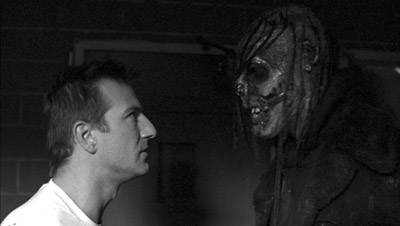
Creator and creation: Franks (Rhett Giles) and the monster (Joel Hebner)
As a whole, Frankenstein Reborn is a bit of a disappointment. At
a running time of only 85 minutes there is surely no time for
explanations or character development. It also shows clearly that the
direct-to-video film was made at a very low budget, most of which was
probably spent for the extremely gory splatter effects. It seems that
the only purpose of most of the film's two-dimensional characters is to
get killed in several gruesome ways. But where Stuart Gordon's
Re-Animator mixed over-the-top violence with humour, Frankenstein
Reborn simply relies on exploitative violence and nudity. It remains
a minor entry in the Frankenstein history and probably will mostly cater
to gore-hounds. Considering the restrained budget, Scott's film still
shows technical skills and is an inspired, yet flawed tribute to both
Mary Shelley and Hammer's Frankenstein series starring Peter Cushing.

|


